
This section contains material from the The Regal Beagle, a former website created by a beagle enthusiast named Pat Robidoux. All content © Pat Robidoux, except where noted. Used by her gracious permission.
Collapse all | Expand all
This article presents an overall description of the beagle. Topics covered include history, temperament, beagles in the field, obedience training, beagles as working dogs, and beagles as pets. After you get acquainted with the breed, follow the other links within the site. Some of the material will make you laugh, other material may make you cry, but all of the information was written with beagle lovers in mind.
History
Although the beagle's origin is uncertain, records of its ancestry point to ancient Greece and France. There is also some evidence that beagle-type dogs were used during the Crusades as an established hunting dog. Talbot Hounds were brought to Great Britain from France in 1066, and are considered to be ancestors to the beagle and the foxhound. England adopted the beagle early in its history, and the hounds quickly became popular with the British monarchy. During the reigns of Edward II and Henry VII, there are many references to Glove Beagles (tiny enough to be held in a gloved hand), and Singing Beagles (named for its bugling voice). Elizabeth I kept packs of Pocket Beagles, dogs measuring only nine inches at the withers, and these little hounds were found on almost every country estate in England.
As fox hunting became increasingly popular in Great Britain, the beagle's existence was threatened. Had it not been for the farmers and small landowners of southern England, Ireland and Wales, beagles may have become extinct in favor of the larger foxhound. In the mid-1800s, Rev. Phillip Honeywood of Essex, England, established pack hounds that are thought to be precursors of the modern beagle. These dogs were bred for their hunting skills, not their looks. Englishman Thomas Johnson is credited with breeding lines of beagles that were fearless hunters, yet attractive.
Beagles were imported to America in 1876, and in 1888, wealthy sportsmen promoted the beagle by forming the National Beagle Club. The club was established to hold pack field trials and bench shows. American breeders began developing beagles that would fit American needs. The English variety of hound had been trained to track foxes and was bred to an average height of 15 to 17 inches at the shoulder. The smaller American beagle was bred for rabbit hunting.
Description
The AKC recognizes two varieties of beagles: those under 13 inches, and others 13 to 15 inches. Hounds over 15 inches are disqualified. Although the beagle standard calls for "any recognized hound color, except liver," most common are the black, tan and white variety; the red and white; and the pale tan and white. The tip of the tail and the feet should be white, and the eyes, dark brown or hazel, are to convey an expression that is "soft and hound like" and "gentle and pleading." The ears are to be set low, long with rounded tips, and should reach nearly to the end of the nose when drawn out. The tail is sturdy and moderately long, and should be carried gaily, but not curled over the back.
Temperament
This energetic little hound is very alert, active and even tempered. The beagle is very outgoing, almost to a fault, and is constantly in need of companionship because it has been bred to be a pack dog. If that companionship doesn't come from other dogs, the beagle will demand it from its owner. It is important that the owner establish himself as "pack leader" and set the rules, or the beagle will find numerous opportunities to run the household. Beagles are usually not aggressive toward other dogs, but they will protect their territory by growling or posturing when appropriate. It is not uncommon for the beagle to play with intruders once they are not regarded as threats. Healthy beagles are extremely hardy and are not fussy about their living quarters. They can tolerate temperature extremes, from North Dakota winters to Florida summers, if given proper care. They should, however, been given a lot of time outdoors because of their desire to hunt. If not given that opportunity, they will find other ways, often destructive, to entertain themselves.
In the Field
In the early 1900s, hunters in rural neighborhood began to organize beagle clubs and hold field trials for hunting rabbits. The number of clubs has grown steadily as has the popularity of the sport. During 1987, 309 beagles earned their Field Championships (as compared to 241 Conformation Championships in the same year). Because of differences in breeding for different purposes, there seems to be a division in qualities between the conformation dog and the field dog. Rarely does a Conformation Champion ever receive a Field Championship and vice versa. A hound of great courage, beagles will literally hunt until they drop. They can be trained to hunt many types of game, including hare, pheasants and raccoons.
In the Obedience Ring
Sometimes much maligned for performance in the obedience ring, beagles may just be misunderstood. Although a highly intelligent dog and excellent problem solver, the typical beagle is easily distracted by scent and can quickly become bored. The handler must understand the beagle for obedience training to be rewarding for both dog and master. Temperament is the most important factor in deciding if a beagle will make a good obedience ring candidate. Shy or easily frightened dogs should be avoided. The best dogs are those who are alert, attentive and willing to please. Unlike a working dog, who has been bred to hang on its master's every word, beagles are bred to hunt and will set their own agendas. In the beagle's eyes, the cricket crossing the hound's path on the long down-stay is probably more important than the will of the handler.
Relatively speaking, few beagles earn obedience titles. In 1987, 17 earned CDs, five achieved CDX Titles, and two were awarded Utility Degrees. However, this number is growing, probably because of more handlers introducing their dogs to the sport. Training a beagle in obedience can give the dog confidence in the show ring for conformation, and will most certainly produce a much better behaved pet if trained properly.
There is no magic formula for successful obedience training, but gentle persistence and making the sessions fun for the dog and handler makes the time well spent. Food works well in motivating beagles, but that should only be used in the initial phases of training. Again, the handler must establish himself as pack leader so the beagle knows who's in charge. Beagles are quick to spot an "easy mark," and will quickly take advantage of a passive handler. The handler must also understand that it may be difficult to obtain high scores that are needed for placements, but he should seize this opportunity as a challenge. If the handler doesn't understand that perfection is nearly impossible to achieve and overworks the dog, the beagle will come to realize that obedience training is no longer fun. The mischievous hound may then create new antics to amuse himself, raising the ire of an unsympathetic handler. Bottom line: Maintain a sense of humor inside the obedience ring.
As Working Dogs
Beagles aren't often thought of as working dogs, such as the German Shepherd Dog, but these hounds have found their place in serving the government. In a pilot program launched in the mid-1980s, the U.S. Department of Agriculture recruited beagles to sniff out contraband food being brought into the United States through airports. These dogs, part of the "Beagle Brigade," sniff baggage for prohibited food articles to battle pests that endanger the nation's farm products. The USDA chose beagles because they wanted dogs that could do the job without being intimidating to travelers. The cute, cuddly beagles were naturals since they are so friendly and have very powerful noses. The dogs are trained to detect beef, pork, citrus fruits and mangoes, although occasionally lime-flavored shaving cream causes quite a stir!
Find out more about the USDA Beagle Brigade.
As Pets
Unlike some breeds that bond to one family member, the beagle bonds to everybody, especially children. However, just as with any other breed, beagles need to be properly socialized and shouldn't be left alone with young children. Beagles play very rambunctiously and can accidentally inflict injury on youngsters. They especially like to play with their mouths by grabbing at things and chewing. Most accidents occur when beagles become overly excited and mistake a hand for a chew toy. Beagles are relatively inexpensive to care for and require little maintenance since they are very clean animals and don't need frequent baths. They are not yappy dogs, but they do have three distinct voices: the bark/growl, the howl and the half-howl, which is an cross between a frantic bark and a howl. The half-howl, usually reserved for the sighting of quarry, is certain to draw attention from neighbors at 6 a.m.
It's no secret that beagles roam. They should be properly fenced when left alone or it's possible the dog will never see home again. Unfortunately, beagles are targets for thieves because they make such good hunters and pets, or they can be sold to research laboratories. Sadly, beagles are one of the top experimental animals, ironically because of the very qualities that make them such good pets: friendliness, gentleness and eagerness to please.
Active, healthy beagles will eat themselves to death if given the chance. Obesity can be a problem, especially in middle age when the dog starts to slow down and doesn't exercise regularly. Beagles live longer than many of the large breeds. The average life span is about 14 years, although 17 years is not unusual. Most slow down around 12 years.
It's not hard to love a beagle. This versatile dog has much to offer dog lovers as a hunter, show dog or faithful companion. Once you invite a beagle into your home, you have found a loyal friend for life.
Dogs may be either "purebred" (of distinct breed with ancestors known through a pedigree or genealogy) or "mixed breed" (a combination of several breeds with an unclear ancestry).
Purebred dogs are registered by kennel clubs who keep official records of ancestry. There are over 400 different breeds of dogs in the world.
The American Kennel Club (51 Madison Avenue, New York, NY 10010) currently registers over 140 breeds. The United Kennel Club (100 E. Kilgore Road, Kalamazoo, MI 49001) recognized or registers 212 breeds. The States Kennel Club (P.O. Box 389, Hattiesburg, MS 39403) recognizes dogs of many rare breeds as well as those recognized by several other kennel clubs.
If you plan to participate in events and activities such as dog shows, field or obedience trials, herding or agility competitions sponsored by these various kennel clubs, it is essential that you have a purebred dog. Each breed recognized by the American Kennel Club has a "parent breed club" that formulates the breed standard (description of the ideal and essential characteristics) for that breed. The parent breed club is a good source of information about a breed. Another advantage to purchasing a purebred dog is the assurance that, if you buy from a reputable breeder, you will have a good idea what your baby puppy will be like as an adult.
For some people, these considerations are not as important as giving a puppy a loving home so they choose to adopt a dog from an animal shelter or humane society or through a national breed rescue program.
Studies show that most people choose a dog:
- Because they like its face or expression
- Because it's the kind of dog they had as a child
Just like individual dogs, no two breeds of dogs are exactly alike. Each breed has a different reason or purpose (what it was bred to do), a characteristic temperament, intelligence, activity level, size and appearance.
Not every breed of dog is suited to every type of person. An informed choice gives you a much higher chance of a successful match. And a carefully weighed decision is especially important if you have children. A mismatch can result in heartbreak or even injury to a child or dog.
When you choose a dog, choose carefully because you are making a lifetime commitment of love and responsibility. Use your head as well as your heart. And the first time you go to look at a particular puppy or litter, leave your money at home to avoid impulse buying.
Here are some important questions to ask yourself:
- How will I know what's the right dog for me?
- How big will this puppy become?
- How active a dog will this puppy become?
- Why was this type of dog developed; what was it bred to do?
- Does this breed have special needs such as professional grooming?
- Have I spent time with puppies, adults, older dogs of this breed?
- How does this breed respond to children?
- What genetic and health problems can typically affect this breed?
- How much does it typically cost to buy, feed and raise a dog of this type or breed?
- What are the important differences between males and females of this breed?
How will I know I am the right person for a dog?
- How much space do I have and do I have a fenced yard?
- Why do I want a dog and what kinds of activities do I enjoy?
- Do I have special concerns like allergies to pet hair?
- Am I prepared to give this puppy a home for its entire lifetime?
- What kind of training am I prepared to give my puppy? Should I consider an older, trained dog?
- How will my children react to a dog?
- Do I have enough information to ask breeds about genetic testing?
- How do I find a good veterinarian and what are the health needs of a growing puppy?
- How much money am I willing to invest in raising as well as purchasing a dog?
- Am I prepared to spay/neuter my dog to ensure that I don't have unwanted puppies?
The Right Breeder...Investigate Before You Buy!
After you have taken the time to select the right breed for you, you need to locate the right breeder. Here are some important points to consider:
- Take time in selecting a breed, a breeder, and a specific puppy. Give yourself several months or more. Avoid impulse buying! Ask dog club members for assistance.
- Remember that ethical breeders DO NOT mass produce puppies to be sold as commodities. Breeders are prohibited by professional codes of ethics from selling their puppies to pet stores for retail! Always buy directly from a breeder. And choose a breeder who answers your questions appropriately and has a well thought out breeding program.
- Puppies should be at least eight weeks of age when they leave a breeder to go to their new homes. Ask breeders how they choose the right homes for their puppies. Do their values match your own?
- A reliable breeder will never use high pressure sales techniques or offer you deals. An ethical breeder will encourage you to study, discuss and visit other breeders. A responsible breeder will insist on learning a great deal about you and your family before agreeing to sell you a puppy.
- A reliable breeder will insist that you agree to spay or neuter your puppy before the breeder gives you proof of ownership (registration papers). This will be part of the breeder's contract with you unless you plan to show your dog to earn its conformation (dog show) championship.
- An ethical breeder will give you a written contract to examine before you buy a puppy. A contract should cover your rights and responsibilities as well as those of the breeder.
- A reliable breeder will give you written copies of genetic testing done on the parents of the litter, including eye testing (Canine Eye Registry Foundation), hip testing (Orthopedic Foundation for Animals), and testing for other conditions such as thyroid disorders, skin and blood conditions. This testing shows that the parents are not affected with certain genetic disorders, but it often cannot guarantee that the parents do not carry genes for the disorders. Your contract with the breeder should state what the breeder will do if you discover your puppy has a health problem.
- An ethical breeder will be happy to have you visit in his or her home to meet one or both parents of the litter, other dogs in the home or kennel, and to see how and where the puppies have been raised. Puppies should always be raised in a home (not a barn, basement or kennel) and be clean, well nourished, happy, alert, playful and outgoing.
Should You Get a Puppy or an Adult Dog?
Puppies...
- Almost everyone loves puppies. They're cute and almost always entertaining. Raising a puppy gives you the opportunity to bond with him from the start, and to train him in your own style.
- Puppies should not be separated from the litter before 7 weeks of age. They need this time to socialize with their litter mates and mother. After 8 weeks, the puppy is ready to move to a human family. You can begin to socialize the puppy to respond calmly when approached by visitors, vets, children and other dogs.
- Puppies also need to be housebroken, and during this time, they will have a few accidents in the house. Puppies also like (and need) a great deal of attention. Some may even chew on furniture because they are bored with you're not around to play. (Crate training may be a solution here!)
- Puppies will also need a series of shots. It's important to go to the vet and find out what you need to do to ensure your pup's good health.
Adult Dogs...
- An adult or older dog who is already housebroken may be a better choice for people who work and don't have time to raise a puppy.
- In addition to being housebroken, an adult dog may be less prone to chewing on furniture, may be more serene than an energetic puppy, and might already know the basic commands of sit, stay, come, heel and down.
- But, adult dogs have special needs, too. Adult and older dogs may be unpredictable in their behavior. For example, every time a dog hears a horn beep he may get upset and bark a lot. This could be because he had a bad experience in the past that makes him behave this way. You might not know the history of an adult or older dog, but you may be able to change behavior with special training and attention.
Questions to ask yourself:
- Will the older dog be able to adapt to a new home?
- How much time can I spend training my dog?
- Do I have the patience needed to meet a dog's needs?
Getting a dog is an important decision. Make a decision that will be good for you, and most importantly, for the dog. If you do decide to get an adult dog, you may wish to contact a local rescue organization for your breed of choice. For a copy of the National Breed Club Rescue Network listing contact AKC's Customer Service Department at (919) 233-9767.
We all love beagle puppies. They're adorable and will steal your heart instantly. But breeding beagles should be left to responsible breeders who have the experience and resources available to produce healthy litters. If you have no intention of breeding your beagle, and your dog isn't show quality, then spa ying and neutering should be seriously considered. The benefits far outweigh potential drawbacks. Walk into an animal shelter and you'll see why altering your pet is so important. Shelters are seriously overcrowded with unwanted animals, and don't think those dogs are merely mixed breeds. Up to one-fourth of the dogs that find their way to various shelters are purebreds.
I was appalled to find a litter of five border collie pups sheltered at the Capital Humane Society in Lincoln, Neb. These four-week-old beauties were dumped with their mother, left to find for themselves at four weeks of age. Who could do such a thing? How could this possibly happen? Fortunately these pups all found homes, but only because someone discovered them in time, before their health declined or they were ripped apart by predators. Healthy puppies are fairly easy to place, but what about the adult dog that is unable to adapt to a family setting and never adopted? Those dogs are destroyed, many the result of poor or unwanted breeding. Altering your beagle normally results in better health and a longer life for your beloved companion. An altered pet is usually a better behaved pet as well.
Many people have misconceptions about spaying and neutering, and most are easily explained:
-
My beagle will get fat and lazy.
- Although it's true that beagles are predisposed to obesity, proper diet and exercise can keep weight problems under control. Don't think that unaltered beagles can't get fat. If they are beagles, they will eat. It's up to you to control calorie intake and establish a good exercise routine for your pet.
-
My beagle will not be able to compete in AKC events.
- It's true that altered dogs cannot compete in conformation, but they CAN and DO compete in obedience, field trials, agility and other competition. If you think your beagle is conformation quality, have that dog examined by a professional who can honestly evaluate the animal for you. We all love our dogs, but most are companion animals, no matter how cute.
-
My beagle's personality will change.
- It might, but that change should be for the better. Beagles have a tendency to roam, and altering can diminish that desire. Your pet should be less aggressive toward other animals after being altered. The tendency to mark territory should also decrease.
-
My beagle will produce cute puppies that I can sell and make money
- Think again. Let's first assume that you have bred your healthy animal with another equally healthy beagle. The offspring will likely be sound, but are you ready for the costs? Consider stud fees, vaccinations, quality food and other vet costs will likely eat up most of the potential profits. Unless the offspring are championship quality, they may not bring a price that will offset all of the expenses. You are also putting your female at risk should she have difficulty in delivering the pups. And if you think that you'll get another dog like the ones you have bred, you'll be disappointed. Few offspring look exactly like one of their parents.
-
My beagle might have complications during the procedure.
- The risk of complications developing from a spay or neuter are usually less than those presented by birth for the female. Placing your beagle under anesthesia always involves a slight risk, but in general, the anesthetics used by veterinarians are quite safe. Your animal's vital signs are monitored during surgery to help ensure your dog is tolerating the anesthesia. The medical benefits still outweigh the slight risk of the surgery. If you have concerns about the spaying and neutering procedures, please consult your vet before proceeding.
-
Spaying or neutering is expensive.
- The cost of a spay or neuter without complications ranges from $30 to $95, depending on where you live and who does the procedure. Some organizations provide assistance for those needing help with the costs of spaying and neutering. Check with your vet or animal control in your city for specifics.
Now let's look at some of the benefits of spaying and neutering:
-
Spaying or neutering increases your beagle's chances for a longer, healthier life.
- Spaying your female beagle prior to her first cycle reduces her chances of developing breast cancer. It also eliminates the threat of uterine and ovarian cancer. Neutering your male beagle prevents testicular tumors and can prevent prostrate problems. Since neutering decreases your dog's desire to roam, your beagle is less likely to contract diseases from unknown sources. The threat of disease from bites encountered by aggression toward another dog is greatly reduced.
-
Your beagle will be a better family pet after it is altered.
- With females, you won't have to deal with the mess and inconvenience that comes with a female in heat. Males won't be howling at your back door, and your female will be able to go out in the yard without the threat of being impregnated. Best reason: You won't be saddled with a litter of unwanted pups. With males, your beagle will be less aggressive toward other males and will be less likely be distracted by females in heat. A neutered male will be less tempted to cross busy streets to find that mate, or mark his territory. His natural urges to mount unsuspecting guests should diminish. He will also respond better to obedience training, essential for gaining control of this sometimes stubborn and strong-willed breed.
-
Your beagle won't be adding to the serious pet overpopulation problem.
- Many of the dogs that end up at animal shelters were given up because they had behavioral problems. Sometimes this is the result of improper breeding. Other dogs are strays that were the products of accidental breeding by unaltered pets. If you walk into the adoption area of an animal shelter, the dogs you see are only a small fraction of those that have been turned in. The others were unsuitable for adoption because of aggression or health problems. They were humanely destroyed by injection and never seen by the public. More than five million cats and dogs are destroyed nationwide each year.
Some final thoughts on spaying and neutering:
Any type of surgery can seem intimidating to a pet owner, but remember that thousands of pets are spayed and neutered each day. If you have concerns about the procedure, ask your veterinarian to explain the unlikely but possible risks. Each animal is different, so go with the advice of a vet that you trust. Naturally some animals can have hidden medical conditions that may pose additional risk.
Your pet will be asleep during the surgery, and the surgical team will closely monitor your dog. Neutering the male is relatively straight forward procedure. The male sexual organs are external, so the procedure is less invasive than the spaying of a female. Following the surgery, your pet may be kept overnight for observation.
Spaying is a little more involved because the sexual organs are internal, but the risk is still low. Following the surgery, your female will probably be kept at least overnight if not a little longer.
When your pet comes home, try to limit running and jumping or excessive play. Also watch for possible infection at the incision site and biting of the sutures. Call your vet if you notice any problems. Be sure you know what to look for before bringing your pet home. The majority of animals don't have problems with these procedures, but the more informed you are, the less stressful surgery will be for you.
I have received several e-mails from woman whose husbands were very much against neutering a male. This is not an uncommon emotional reaction. My husband put up a bit of resistance before Spencer was neutered. He feared castration would make Spencer less male. Not true. Perhaps the issue is simply sensitive because of the nature of the surgery. Our vet assured us that many men take the surgery "very personally."
I know I've provided you with a lot of information, but I urge you to consult with your veterinarian prior to proceeding with the surgery.
You may find that some breeders require you to enter into a spay/neuter contract before selling their dogs. What this contract usually involves is releasing the AKC registration papers only AFTER the new owner has written verification that the animal has been altered. Don't be offended by this contract. These breeders are working for the betterment of the breed.
I am a strong advocate of spaying and neutering. I only hope that I have explained why this is such an important part of responsible pet ownership.
We all love our pets, but...
At our home we have two wonderful beagles. In our eyes they can do no wrong -- well, almost. Both are obedience and crate trained. The perfect dogs, right? Not always. They have their moments! Why? Because they are animals first, then our loving companions.
Renting with pets can be somewhat of a challenge for both tenants and property owners. Many places do not allow pets for several reasons, most often the fear of damage. Landlords are also wary of liability issues. If an animal bites, the owner is held responsible, and, in some cases, so is the landlord.
Even the most well-behaved pet can have accidents or get sick. Others are uncomfortable in unfamiliar surroundings and can suffer from separation anxiety or boredom. Sick dogs and cats can soil the carpet. Anxious and bored animals may damage doors, windows, anything they can find.
Confinement helps reduce damage to the living quarters and increases safety for the pet. Some landlords prefer that potential tenants crate their pets. Unfortunately, many people do not understand the concept behind crate training, a common practice we have used on our two dogs since they were six weeks old. As a result, the animal is left to roam the unit or is confined to a room. This poses some serious problems for the property owner.
There are times when the landlord or repair people must enter the unit on an emergency basis. If an animal is left to run free, it may escape the building or pose a threat to people who must make repairs.
Unless a dog is conformation quality and is suitable for breeding, there is no reason it cannot be spayed or neutered. The benefits of altering an animal far outweigh the negatives.
A size restriction may be placed on dogs for obvious reasons, often 20 pounds for an adult dog. The larger the dog, the more space it will require. Many apartments do not have a yard. Duplexes and four-plexes may, but the neighbors must be taken into consideration. Most property owners do not allow outdoor kennels, so dogs must be house pets and be of a reasonable size. Tethering a dog for an unreasonable length of time is cruel and should not be tolerated.
If you are renting and are considering getting a beagle, think about it very hard. They can adapt, but many a dog has found its way to the animal shelter because tenants cannot find proper housing. Your current landlord may be wonderful, but caring for a pet is a life-long commitment, and you will eventually move. Will your next landlord be as accepting? Maybe. Maybe not.
Sample Pet Policy (Compliments of Robidoux Rentals)
All cats must be litter trained, declawed, spayed or neutered. All dogs must be less than 20 pounds, spayed or neutered and preferably kennel trained. All pets must have a proven and traceable track record with other landlords as to their good behavior and owner's maintenance responsibilities. All pets must be current on vaccinations and have written documentation of this from a licensed veterinarian. The landlord or his agent has the right to observe the pet's size and temperament before applications are accepted. The number of pets allowed and the acceptance of animals will be left to the discretion of the landlord. Animals specially trained to assist those with disabilities are not considered pets and are exempt from this policy. An additional $100 deposit (higher for some units) is required for all tenants who care for pets in their units, AND a $25 pet rent is assessed monthly in addition to the base rent of the unit.
Tenants Ten Commandments for Renting with Pets:
I promise I will...
- Faithfully pick up after my pet, including yard waste.
- Exercise my pet regularly in an area meant for that purpose.
- Make sure my pet is confined, preferably in a kennel, to keep my pet safe and help control potential damage.
- Introduce my pet to my neighbors. Many people are wary of unfamiliar animals.
- Not leave my pet outside when I'm not home.
- Have someone who can look in on my pet if I am away for long periods of time, or I will arrange for boarding during vacation times.
- Report all pet damage immediately so the landlord can minimize the cost of repairs. I will not attempt repairs myself without authorization from my landlord.
- Control pet odor. This is a BIG complaint of many landlords/neighbors.
- Control barking. Probably the BIGGEST complaint from neighbors.
- Never sneak a pet into my unit without permission of the owner!
Lady of the Pack, Coki...

AKC-registered Princess Coki-Cola was whelped on March 11, 1994, in Lincoln, Nebraska. At four months, Coki began her obedience training and has completed beginning basic obedience, intermediate obedience and Novice-ready classes through the Greater Lincoln Obedience Club (GLOC). She earned her Canine Good Citizen designation on June 7, 1997. We enjoy training together and eventually hope to work toward Coki's CD title. Other beagle owners can relate to how difficult it can be to train beagles for obedience, but although the challenge is great, the reward is priceless. Coki has also finished her first tracking class. Let's just say she "nose" what's she's doing!
Coki responds to most hand signals for basic commands and is crate trained. Although stubborn, she is a well behaved dog... when she wants to be. Coki enjoys chasing squirrels in our backyard, and they always know when she's coming because she has a beautiful beagle howl. She's never been a chewer and is respectful of all the "human" things in the house. In other words: if it isn't hers, she usually won't touch it.
Coki was named after my favorite soft drink and a favorite snorkeling spot in St. Thomas, USVI: Coki Beach. A strong, muscular dog, she stands 14 inches at the shoulder and and weighs 33 pounds. In the interest of responsible pet ownership, she was spayed in September 1994.
My Little Tiger, Spencer...

Spencer Tiger by the Tail is Coki's full-blooded brother, whelped on November 23, 1995, in Lincoln, Nebraska. Also AKC registered, Spencer began his training in Puppy Manners at three months of age and has completed two beginning basic obedience classes through GLOC. Spencer received his Canine Good Citizen designation on Dec. 13, 1996. Spencer has also finished a tracking class and a dog tricks class using the clicker training method. He has learned to beg, turn circles and wave "Bye-Bye." Yes, it's cute!
Spencer is an energetic dog that loves to play. He is very eager to please, making him a good candidate for many different dog activities, including flyball and agility. He responds to basic verbal commands and will come when called 95 percent of the time (a true beagle miracle). This dog may never grow up! He has that wonderful beagle attitude and will be known as "forever puppy." Spencer is also crate trained. He'll do anything for food!
Everyone who knows me can guess where Spencer's name originated. He is named after my hometown, Spencer, Iowa. My high school's nickname is "Tigers," so thus his AKC name. He is tall and slender, standing 15 inches at the shoulder and weighing in at 32 pounds. Spencer was neutered in July 1996.
A Very Special Friend, Reggie...

Spencer and Coki aren't the only beagles who have been important to me. My buddy Reggie (1980-1994) was one in a million. Originally named Snoopy, Reggie came home with us at six months of age -- just old enough to have acquired some bad habits.
Reggie was one dog who most certainly should have been introduced to obedience training. We spoiled him rotten, and he got away with murder. Is it no wonder that this dog ran the household! He was a spirited animal, even as he aged, and his ability to understand words and feelings was incredible.
Reggie was notorious for his ability to sniff out trouble, whether it be a two-pound block of cheese or a large cosmetic sponge. The latter landed him on the operating table! Not a day goes by that I don't think of Reggie and his antics. Reggie was such a wonderful companion. His epitaph: "He loved everybody."
My First Beagle, Thumper...
When I was eight years old, I ran through a thicket of cockleburs to meet my first dog Thumper (1964-1979). I fell in love immediately! Thumper was a kind and faithful friend for the 15 years as we grew up together. Of all my beagles, Thumper was the least social toward strangers and the most afraid of going to the vet. He was my only beagle to suffer from epilepsy, a health problem sometimes found in the breed. But even today, I still fondly remember Thumper and his very vocal howl!

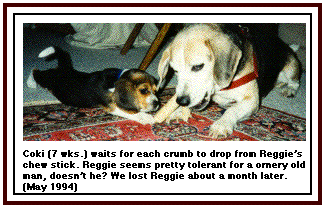
What would I do if I had two? That thought never entered my mind until April 1994. I'd always been a one-beagle woman, and I couldn't imagine my husband John as a two-beagle man. We'd just celebrated two years of wedded bliss, and John didn't even know what a beagle was until I marched into his life with aging, but resilient Reggie. One beagle I knew I could handle, but TWO? Get outta here!
Blame the darn Sunday paper for the whole thing. There it was: AKC BEAGLE PUPS FOR SALE. I read the ad and then tossed the paper aside. I knew I couldn't be tempted by something so irresistible. Some things you just can't defend against -- like perhaps the alarming cuteness of the most adorable puppies God ever put on this earth.
But naive John, my oh-so-curious husband, thought it would be "fun" to "just go take a look." I warned him. "I'll come home with one." I pleaded with him not to subject me to the torture of gazing in those dark chocolate brown beagle eyes only to have to walk away from a litter of love. But foolishly, John couldn't let sleeping dogs lie.
John was persistent. He reminded me that Reggie, 13, was aging. Perhaps he needed a little playmate. No! Never!! Reggie would not allow it!!! He was the TOP DOG. Our house was HIS HOUSE, and no intruding little creature would be competing for our attention.
Well, it wouldn't hurt just to look. I knew what to expect. They would be cute all right, but I was prepared. No soft spots in my heart. No piddling little puppy, no matter how adorable, was going to christen my carpeting.
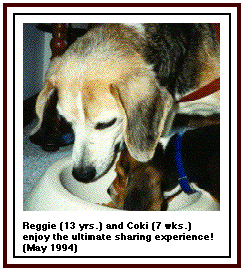
Coki came home with us five hours later on April 24, 1994. John was terrified. He never thought I'd actually do it, and I even surprised myself. But once we got there and saw five healthy beagles all competing for our attention, my defenses crumbled and I relented. John wanted to take a lunch break to "think it over." I pouted a bit as we started back to town and kept repeating, "You're driving away from the puppies." He finally turned the van around and then stood helplessly by, watching in horror as I added another four-footed companion to our little family.
Introducing a new puppy into a household that already had an older dog might have been disaster. I had no idea of how Reggie would act. He was slowing down, and Coki was a "wiggle worm," full of fire and endless energy. What was I thinking?! But much to my relief, Reggie seemed to delight in having a new four-footed admirer. Whatever Reggie did, Coki mimicked. She shadowed his every move. He even initiated play on many occasions. And she didn't disappoint -- always ready and willing.
Just as their friendship began to bloom, Reggie's body finally shut down. A beagle buddy for just two months, Reggie was suddenly gone, succumbing to cancer on June 18, 1994. Coki, still 100 percent puppy, became my rock. In her eyes I saw Reggie's youth. In her movements I saw Reggie's antics. In her spirit I saw Reggie's heart.
For the first time in her short life, little Coki was suddenly without beagle companionship. I swear she actually grieved for him. But life goes on -- one beagle or two.
We became one close-knit trio. Coki got the bed. Coki got the sofa. Coki got the whole dang house. But she never took anything she wasn't offered. If she had stolen a particular December 1995, Sunday paper, our lives wouldn't have taken another unexpected turn.
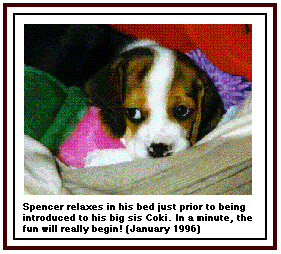
AKC BEAGLE PUPS FOR SALE. There it was again! And the phone number was the same. I knew destiny as it stared me in the face.
Spencer had barely opened his eyes when we got our first glimpse of him at 18 weeks of age. Of course I knew he wouldn't be coming home until after Christmas, and the wait was excruciating. Every week I had to slip over and see how "our Spencer" was doing. The changes from week-to-week amazed me. My little "baby" was growing up!
When I wasn't visiting him, I was planning for Spencer's arrival. His Christmas presents sat under the tree, and his stocking was brimming with puppy toys. Next to Coki's crate sat another. Oh Spencer! Hurry home!!
The big day finally arrived, but it was not without a bit of thought and preparation. We knew Coki would probably accept her little brother, but realistically we couldn't expect her to take an immediate liking to him. With that thought in mind, we took Coki's crate upstairs to our bedroom and confined her while we went off to bring Spencer home. Our intentions were to introduce Spencer to his new surroundings gently without Coki's monster sniffer in his face.
Actually, I wasn't as concerned about Spencer's adjustment to our home as I was about Coki suddenly acquiring a sibling. How was she going to respond to sharing the household with her tiny brother? Would she accept the new boundaries and routines? How could we make her feel like she was still a very important part of our lives while we were fussing over a tiny puppy?
To alleviate some of these problems, we decided we would establish Coki as the dominant dog. We would feed her first and extend her extra privileges. She would get "quality time" alone with each of us. The last thing we wanted was a sibling rivalry.
I felt like a mother taking her newborn from the hospital that frigid January morning. Spencer had never been outside because our winter temps had hovered below zero for several weeks. I held him close as we pulled into the driveway, my heart racing. Was I nuts? What on earth made me think that I could ever handle two?
We spent about an hour introducing Spencer to his basket and toys. He seemed overwhelmed by all of the attention, but loved every moment of it. First the squeaky turtle, then the ball and finally the fuzzy hot dog. He frolicked amidst a mountain of toys, oblivious to the real life furry monster upstairs.
Finally it was time. I decided to put Coki on her leash for the introductions. She had a decided weight advantage with Spencer weighing in at less than 4 pounds. I couldn't risk a possible injury. First impressions could make or break this future long-term relationship.
Coki spotted him right away and pulled me over to his basket next to the sofa. Her tail stood straight back and the hair on her back rose at least an inch -- if not two. I braced for a forward charge. Then Coki suddenly lifted her tail and waved it proudly over her back. She sniffed an unsuspecting Spencer with the tenderness of a mother, and he responded with a tiny whimper and a lick. Startled, Coki jumped back and stared at him with the biggest eyes I'd ever seen.

Moments later it was play time! Spencer ran nipping at Coki's floppy ears, and Coki kept jumping on the sofa, away from his assaulting puppy teeth. But Coki was so gentle. She could have snapped his little neck if she wanted, but she was careful, deliberately jumping over him so he wouldn't be crushed under 30 pounds of pure beagle muscle.
I would have never introduced Spencer to the household unless Coki had taken numerous obedience classes. She responded well to commands, so I could keep her under control in the house. I knew how to handle a pup and what steps to take to socialize Spencer with children, adults and other dogs. Without these skills, I could have had two wild monsters!
Even with all the "saintly" behavior on Coki's part, she did experience a bit of sibling rivalry. Out of the blue, she would squat and "make a statement" on our bed or our best rug, looking both of us right in the eye. Her behavior was that of a spoiled child who suddenly found out that all of our attention wasn't directed at her. She didn't like it one bit and retaliated. But she never took her frustration out on Spencer. Oh sure, they had their little battles, but never anything to be concerned about. Unless food came into the picture.
As Spencer has matured, the battle for a kibble has become more of an issue. Although he is the submissive dog, he is very protective of food. One lip curl and "that look" starts it -- snarling, teeth flashing, the works. Then I stop it. I have no problem stepping right in and breaking up the ruckus. A firm scruff of the neck for each dog and a "time out" in the crates quickly defuses the situation. Then after a few moments, those dogs are their mannerly selves.
Just as Coki mimicked Reggie in her young life, Spencer mirrors Coki's every move, especially outside. Coki howls at squirrels. Spencer howls at squirrels. Coki runs to the window. Spencer runs to the window. Coki wants a drink from the bathtub. Spencer is right behind her.
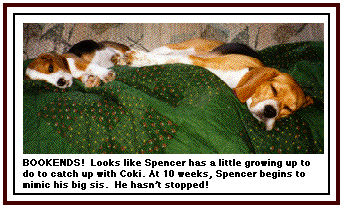
Both are extremely loving -- snugglers on a cold winter's night. But don't be fooled. These dogs have totally different personalities. Spencer lives to play with his tennis ball. Coki ducks when I pitch it in her direction. Coki is always outside hunting for prey. Spencer goes through the motions. The minute he sees me, he'll race to the back door. Coki loves tracking. Spencer loves agility. Both tolerate obedience.
The key to living in a happy household with these two wonderful beagles is understanding each's strengths and weakness; likes and dislikes. We have our trials and tribulations, but the love these two bring into the home more than offsets the hard work it takes in caring for our wonderful companions.
I can't imagine our home without Coki and Spencer underfoot. They are wonderful dogs 99 percent of the time, but that other 1 percent... whew, it's double trouble!

Are you ready to take on another companion?
Let's take a look at what you should consider before taking the plunge.
- Do you have a beagle that is obedience trained and gets along with people and other dogs?
- If you already have a dog that has some behavioral or obedience problems, correct those before introducing a second animal. A second dog can easily learn those bad habits, and then you'll have far more than you've bargained for. A second dog will not suddenly solve problems you have with a disobedient pet. Many experts suggest that the first dog be at least 18 months older than the second. This way, you don't have two dogs to housebreak and obedience train at one time. Let the second dog learn from a good example. Have one dog under control before acquiring the second.
- Can you financially support both dogs through their entire lives?
- Double all costs. Both dogs need vet care, obedience training, food and living quarters. Accidents happen. Do you have the resources to handle unexpected vet expenses? Do you travel? If so and you board your pet, double those costs if you aren't able to leave your dogs in the same run. Our boarding bill for a recent two-week vacation was more than $350 for Coki and Spencer. Food costs double as well. I'm not trying to scare you, but be prepared.
- Do you have room for another dog in the household without sacrificing the comfort of other family members or your other pet?
- This may seem obvious, but really think about it. Will a second pet cramp your style? Do you physically have room for two? You don't if you live in a small one-bedroom apartment. Those dogs need space to exercise. Beagles can be very active and need room to run. Be careful not to squeeze your first pet out of its "space." Each dog needs a place to call its own.
- Do you have time to devote equally to both dogs?
- One dog is a huge responsibility. Two can be overwhelming if you aren't prepared. Each dog needs individual attention -- training, exercising and grooming. You will also want to give each dog equal time. Don't shortchange one for the other. My dogs have a way of knowing who is getting more attention, and each will let me know about it. Spencer will chew things to get more attention, and Coki will let her bladder do the talking.
- If your dogs are similar in age, are you emotionally prepared for losing your companions within a short time of each other?
- This is one of the most difficult things to face. When your dogs are young and healthy, they're fun to play with and have around. But when they are in their later years, health problems pop up. Can you give your aging companions the care they need when aging catches up with them? When the end comes, you will experience a compounded grief. Losing a pet is extremely difficult. Losing two close together may be too much for you. If this is too much for you to handle, consider adding your second companion when your first is well into adulthood.
Pets are wonderful, aren't they? I was reminded of that when I thought about my buddy Reggie. And how could I not think of him? There's something about the sight of a 30-pound beagle rifling through a refrigerator that stays imprinted in my mind.
I only left the room for a few minutes, but that was plenty of time for Reggie to inhale a two-pound beer sausage, a loaf of bread and a brick of cheese. It's a well-known fact that this dog is a four-legged garbage disposal, but what puzzles me is how he opened the refrigerator door.
I wanted to scream, kick, swear or at least threaten him with a rolled-up newspaper, but those big, brown eyes and that bloated stomach told me the spoils of his crime were punishment enough.
Why, with all this aggravation, do people choose to include pets in their lives? Pets, especially dogs and cats, can be very expensive for the responsible owner. I estimate I spent over $700 on Reggie during the year and that doesn't include the $400 for emergency surgery when he decided a cosmetic sponge was probably a pancake.
Most pets also require a great deal of care. Sadly, this is a responsibility many individuals underestimate and the results are unhappy people and abandoned or destroyed animals.
Pets are welcomed into a family for many reasons. Dogs, for instance, have a multitude of talents.
When I purchased Reggie, I was told he would be an excellent hunting dog, and at six months of age, he could already retrieve on land and water. It didn't take long for me to realize that this was simply a marketing ploy. Reggie doesn't retrieve, he seeks and destroys, and he cowers when I even look at a garden hose.
Many dogs are often used for protection. Not Reggie. He's a big-hearted happy hound who loves and trusts everyone. I'm sure he would gladly invite intruders into the house and show them right to my jewelry box. I imagine he would also lick their hands as they picked up the TV and the VCR and headed out the door.
Pets can also teach children responsibility, and many times youngsters are first exposed to death through the loss of a pet. I know I planted my share of goldfish and turtles in the backyard when I was a child. This grieving process is healthy for children and teaches them how fragile life really is.
Pets are known to be great companions for those living alone. I find a great deal of satisfaction in knowing I am caring for an animal who needs me and returns my love, expecting nothing in return.
The decision to introduce a pet to the home should not be taken lightly. Although pet ownership has endless rewards, it is not without frustration, sacrifice and heartache.
Pets are wonderful, but only when nurtured by caring and responsible owners. We have all heard that you can't buy love, but I'll always believe my $75 investment for a small beagle pup was the best investment I ever made. I know I'll always welcome those PAW prints heading to the refrigerator. I'll just have to get a beagle-proof lock!
Starting the search for a Responsible Breeder
- Attend an event such as the America's Family Pet Show and talk to people who own the breed you want.
- Attend a local dog show. Show catalogs list the names and addresses of the owners of entered dogs. You can also talk to the owners and handlers of the dogs (though not when they're about to go into the ring!) and get some leads that way.
- Write to the AKC and ask for the names and addresses of breed clubs. These clubs can steer you in the right direction.
- Learn about your breed before you look to buy one. Read the breed standard, find out about grooming requirements, typical temperaments, health problems that are common in the breed, etc. Irresponsible breeders hate educated buyers!
- Price alone should not be a factor in deciding what breeder to buy from. While a high price doesn't necessarily guarantee high quality, a very low price often does not turn out to be a bargain in the long run. Find out what typical prices are for show and pet quality puppies of your breed in your area.
- Be patient. You may have to wait a few months (or longer) to find the right dog from a good breeder. This is a very short time compared with the ten to fifteen years that a dog will live with you.
Responsible Breeders DO:
- Breed in order to improve the breed and produce the best puppies they possibly can, and usually plan to keep at least one of them.
- Ask as many questions of you as you do of them.
- Show evidence of at least two or three years of serious interest in their breed, i.e. dog club memberships (the AKC doesn't count!), show and match ribbons, and Championship and/or performance (obedience, agility,tracking, field, etc.) titles.
- Breed only dogs that closely match the breed standard and are free of serious health and temperament problems.
- Tell you if they think you would be better off with another breed of dog, or no dog at all.
- Provide referrals to other breeders if they don't have anything available.
- Use a written contract and guarantee, or at least an oral agreement, when selling a dog, with clear terms that you can live with.
- Provide a registration slip, a pedigree, and up-to-date shots/health records with every puppy they sell.
- Honestly discuss any special problems/requirements associated with the breed.
- Offer assistance and advice on grooming, training, etc., for the life of the dog.
- If, for any reason and at any time, you cannot keep the dog, will take it back.
- Normally breed only one or two litters a year, max!
- Have dogs that are clean, healthy, happy, and humanely cared for
Responsible Breeders Do NOT:
- Appear overly eager to sell/"get rid of" a puppy
- Breed simply to produce puppies to sell
- Breed a bitch on every season, or more than once a year
- Have breeding stock that consists of a "mated pair"
- Claim that all of their puppies are "show/breeding quality"
- Claim that their breed has no problems (some have fewer than others, but every breed has at least a couple)
- Sell puppies to pet stores or to anyone that they have not met/screened personally
- Sell puppies that are less than eight to ten weeks old
- Sell puppies without papers (registration slip and 3-5 generation pedigree), or charge extra for papers
- Have more than one or two litters at any given time, or litters of multiple breeds
- Guarantee their dogs, or if they do, attach such unreasonable conditions to the guarantee, i.e., "dog must not be spayed or neutered, must never have been bred, and the ears must stand correctly," that it is unlikely that they would ever have to honor it
Phrases to be aware of in Breeders' Ads:
-
"Rare"
- This is often because either the breeder is using the wrong term for a common trait (i.e., "teacup" for toy size) or the dogs in question have a trait that no responsible breeder would deliberately produce, either because it is not allowed or is considered a serious fault in the breed standard, and/or is associated with health problems in the breed (e.g. white Boxers and Dobermans, parti-colored Poodles, "king" Labs, lemon spotted Dalmatians, and blue-eyed Malamutes). Although it can also mean that the breed is not well known or widely recognized, it does almost always mean that the breeder expects you to pay megabucks for the privilege of owning one.
-
"Aggressive"
- Most dogs are naturally protective, the extent depending on their breed and individual personalities. Why would anyone in their right mind deliberately breed dogs with unstable temperaments?
-
"Champion"
- A dog becomes a breed champion by earning points defeating a specified number of other dogs of its breed in competition. A dog can have a whole wall full of blue ribbons, yet still not have earned a single point, let alone a championship title.
-
"Grand Champion"
- The AKC does not award a Grand Champion title. Some other registries do, such as the UKC, but make sure the breeder explains how and where that title was earned.
-
"Champion lines"
- Almost all dogs have some champions in their pedigrees if you go a few generations back. Ideally, at least one parent and the majority of the dogs listed in the pedigree should have a championship or other title.
-
"Champion puppies"
- Dogs cannot be shown towards a championship before they are six months old. Maybe the breeder means that the parents are champions. Maybe it means that you'd be better off buying from somebody that's honest.
-
"OFA puppies"
- OFA stands for Orthopedic Foundation for Animals, a registry that screens dogs for hip dysplasia. Dogs must be at least two years of age to be screened. If a breeder claims that any dog younger than that has OFA numbers, run!
-
"Show quality"
- What does the breeder mean by this? Expected to finish a championship fairly easily? No disqualifying faults? Has "perfect markings and is really cute?" Make sure you understand exactly what this means before you buy. By the way, unless you are serious about breeding and showing, there is nothing wrong with a dog that is "pet quality."
-
"AKC registered" (or just "AKC")
- The AKC (American Kennel Club) is a registry that issues registration papers to dogs of the approximately 140 breeds that are currently recognized, whose parents were also registered. While great to have (essential if you plan to show and breed), AKC registration is no guarantee of a dog's quality, or of a breeder's integrity. Other popular registries include the United Kennel Club (UKC) and the American Rare Breeds Association (ARBA), as well as breed-specific registries such as the Australian Shepherd Club of America (ASCA). One warning: There are a number of "effigy registries" whose sole purpose is to provide "papers" for dogs who cannot be registered through one of the legitimate registries (breeder may have been banned from legitimate registry, parents may not be registered or registerable with legitimate registry, etc). If you are not familiar with the registry in question, ask around.
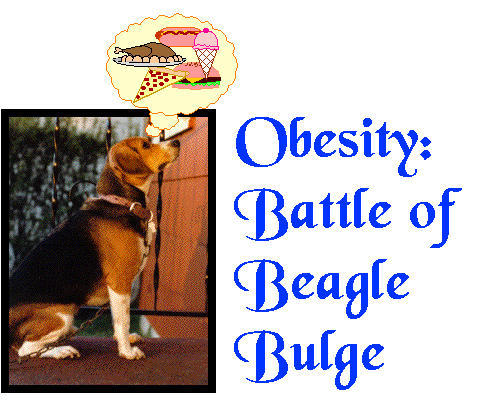
If you own a beagle, you will probably be fighting the Battle of Beagle Bulge as your dog grows into adulthood. Beagles appear to be predisposed to obesity, so maintaining a healthy, consistent diet is vital to your dog's good health. Those few extra pounds can suddenly blossom into a severe problem with obesity, compromising your beagle's good health.
Severely overweight dogs, like overweight people, are more likely to develop health problems, some potentially life threatening. Joint and muscular problems can be complicated by obesity. Liver and skin problems occur more often. Diabetes is an added risk. Obese dogs also are more susceptible to to pancreatitis. These health problems are no doubt expensive to treat, but they also can shorten the dog's life and threaten his quality of life.

Should You Travel With Your Companion Animal?
Some pets are not suited for travel because of temperament, illness, or physical impairment. If you have any doubts about whether it is appropriate for your pet to travel, discuss your plans with your veterinarian. If a friend or relative is going to take care of your pet, ask if that person can take your pet into his or her home. Animals can get lonely when left at home alone. If you choose to board your pet, get references and inspect the kennel. Your veterinarian or local animal shelter may give a recommendation. If you are hiring a sitter, interview the candidates and check their references. (A pet sitter may be preferable if your pet is timid or elderly and needs the comfort of familiar surroundings.)
The Pre-Trip Veterinary Examination
Before any trip, have your veterinarian examine your pet to ensure that he or she is in good health. In addition to the examination, your veterinarian should provide necessary vaccinations such as rabies, distemper, infectious hepatitis, and leptospirosis. If your pet is already up-to-date on these, obtain written proof.
Travel Carriers
Travel carriers are useful when your pet is traveling by car; they are mandatory when your pet is traveling by air. Choose a carrier with a secure door and door latch, a grille door, and several ventilations holes on each of the four sides.
To introduce your pet to car travel in the carrier, confine him or her to the carrier and take short drives around the neighborhood. If properly introduced to travel, most dogs and cats will quickly adjust to and even enjoy car trips.
Careful Preparation is the Key
- Your pet should wear a collar with ID tags throughout the trip.
- You should keep feeding to a minimum during travel.
- Allow small amounts of water periodically before and during the trip.
Traveling by Car
Dogs who enjoy car travel need not be confined to a carrier if your car has a restraining harness (available at pet-supply stores.) Because most cats are not as comfortable traveling in cars, for their own safety as well as yours, it is best to keep them in a carrier. Dogs and cats should always be kept safely inside the car. Stop frequently to allow your pet to exercise and eliminate. Never permit your pet to leave the car without their collars (and ID tags) and a leash. Never leave your pet unattended in a parked car. On warm days, the temperature in your car can rise to 160 degrees in minutes.
Traveling by Air
The Humane Society of the United States recommends that you do not transport your pet by air unless absolutely necessary. If you must transport your companion animal by air, call the airline to check health and immunization requirements for your pet. If your pet is a cat or a small dog, take him or her on board with you. If your pet must travel in the cargo hold, you can increase the chances of a safe flight for your pet by following these tips:/p>
- Use direct flights.
- Always travel on the same flight as your pet.
- Fit your pet with two pieces of identification -- a permanent ID tag with your name and home address and telephone number.
- Affix a travel label to the carrier, stating your name, permanent address and telephone number, and final destination.
- Your pet should not be given tranquilizers unless they are prescribed by your veterinarian.
- Do not feed your pet for four to six hours prior to air travel.
- Try not to fly with your pet during busy travel times such as holidays and the summer.
- Carry a current photograph of your pet with you.
- When you arrive at your destination, open the carrier as soon as you are in a safe place and examine your pet.
Traveling By Ship
With the exception of assistance dogs, only a few cruise lines accept pets -- normally only on ocean crossings and frequently confined to kennels. Follow the general guidelines for other modes of travel when planning a ship voyage.
Traveling By Train
Train travel causes minimal stress to animals; however, you should make all the preparations outlined in other sections of this document.
Hotel Accommodations
There are approximately eight thousand hotels, motels, and inns across the United States that accept guests with pets. Most hotels set their own policies, so it is important to call ahead and ask if pets are permitted and if there is a size limit.
Do Your Part To Make Pets Welcome Guest
Many hotels, restaurants, and individuals will give your pet special consideration during your travels. Obey local animal-control ordinances, keep your animal under restraint, be thoughtful and courteous to other travelers, and have a good trip.
©Humane Society of the United States (Used with permission)


John and I worried for a week over Spencer who at 18 months old suddenly became ill on April 13, 1997, from seemingly unknown causes.
We first noticed Spencer was lethargic, shuddering and seemed to be in pain. He walked with a "hunch" in his back and was hesitant about climbing up on the sofa or going up steps. An emergency visit to the vet that day showed a high white count of about 19,000 and a 105 F fever. At first thought, we suspected a possible back injury, but x-rays revealed nothing. Additional blood tests only showed the high white count. Everything else seemed normal. Our local vet kept him and treated him with antibiotics and fluids for two days.
Spencer seemed to show some improvement so he came home the evening of April 15. The next day, he had a fever, which spiked in the morning and evening at about 104.5 F. All during the day, he slept on the sofa. I checked his temperature every two hours or when I noticed him shuddering, an indication of a high fever. Then in the early hours of April 17, I checked on him around 4 a.m. He looked like he was drawing his last breath, and I could see his little heart pounding in his chest. In tears, we rushed him back to the vet clinic at 5:30 a.m.
Since Spencer's white count had increased, and the antibiotics had been ineffective, our vet suggested that we take him to the College of Veterinary Medicine at Iowa State University in Ames where they could do a spinal tap and EMG to check him for meningitis. Most local vets are not equipped to do spinal taps nor do the lab work that goes with it, so Iowa State was our closest facility.
We picked him up at the vet clinic around 5:30 a.m. April 18 and rushed over to Ames for our 10 a.m. appointment. He was a real trouper during the 4-hour drive. He rode in his crate right behind me while John drove. I kept reaching back to stroke his ears, which he seemed to enjoy. Although we were still very concerned about him, I felt confident that the doctors at Iowa State would be able to diagnose and treat his condition.
John and I were very impressed with the professionals at Iowa State. Spencer was examined thoroughly by two specialists, and the preliminary diagnosis was necrotizing vasculitis, sometimes called "Stiff Beagle Syndrome." A spinal tap was needed to confirm the diagnosis and rule out meningitis or any other disorders.
One of the hardest things I had to do was leave Spencer in Ames, but Dr. Julie Ridgway, Spencer's primary doctor, assured us that the condition was treatable once it was diagnosed. She said she had only seen one other case of necrotizing vasculitis, and Iowa State gets a lot of unusual cases because it is a teaching hospital. Dr. Ridgway, who is from England, had actually suspected this disorder before she saw Spencer.
Necrotizing vasculitis, although rare, can occur in beagles at 6-12 months. Although Spencer was 18 months, he was showing all the major symptoms: spiking temperature, muscle and joint stiffness, profound lethargy, and an elevated white blood count.
Dr. Ridgway's diagnosis was confirmed with a spinal tap, and we knew the answer by the end of the day. The tell-tale signs were a high white count of 4,000 in the spinal fluid (normal is 1-5) and then the absence of any bacteria. They put him on different medication, and Spencer was responding well within hours. He remained in intensive care for two days, and his symptoms disappeared. We brought Spencer in on a Friday and happily picked him up the following Tuesday.
Spencer is taking a very high dose of the steroid Prednisone (20 mg/ 2 times daily. Since Prednisone commonly causes stomach upset, Spencer is also taking canine equivalent of Tagamet (Cimetidine), which was discovered by Dr. Ridgway's professor. Small world!
Because of the high dosages of steroids, Spencer drinks water by the bucketful and wants to eat everything in sight. The medication also tends to make him quite sluggish, so he lays around a lot. Basically he acts like a 10-year-old dog except when food and water are involved. He will have to take steroids for a few months, but the dosage should be decreasing soon. The good news is that he doesn't seem to have any permanent damage because the condition was diagnosed so quickly. We were also told that the symptoms usually do not reappear, especially as the dog grows older.
Since necrotizing vasculitis is so rare and occurs only in certain breeds of dogs, few veterinarians have heard of it. I am scrambling to find some more information to post at The Regal Beagle site just to make people aware of the condition. In my 32 years of having beagles, I had never heard of such a disorder. From what I understand, I'm not alone. I have not found a veterinarian in small animal practice that has seen or even heard of the disorder in beagles.
I want to stress that necrotizing vasculitis is quite rare, but should your young beagle ever experience symptoms much like Spencer's, have your local vet check him for common maladies. If your beagle goes undiagnosed and does not improve, mention this disorder. I'd hate to see a beagle put down because a rare condition went undiagnosed. Necrotizing vasculitis is treatable, and with proper care, Spencer should be his old self after he kicks the steroid habit!
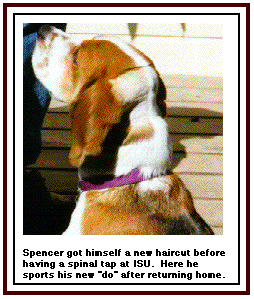
Updates:
July 31, 1997: Spencer is doing very well! He shows no signs of ever being affected with this disorder, but continues to take medication once a week. We are so thankful to have received such wonderful medical treatment, both from our local vets and from the staff at Iowa State.
June 27, 2000: You would never know that Spencer had ever been so ill. He's going to be five in November and is a very active little dog who loves to play! Although he still shows symptoms of necrotizing vasculitis every few months, we treat him with Prednisone the second we notice a problem. The biggest tell-tale symptom in his case is "bowing." He'll rest on his forelegs and leave his rear elevated. When I see him doing this, I immediately start him back on medication, usually 5 mg of Prednisone once daily for a couple of days, then down to every other day until he's properly weaned off the meds. We have not yet found the lowest effective dose for him. ALWAYS check with your vet when administering medication. Prednisone is a steroid and dogs cannot be removed from it "cold turkey." It also can cause liver and kidney problems if used for extended periods of time, so Spencer is closely monitored by our veterinarian.
Facing Grief When we Lose Our Pets
We grieve over the death of a pet. This reaction is only natural. our feelings toward pets are so special that experts have a term for the relationship: the human-companion animal bond. When this bond is severed, the sense of loss can be overwhelming.
Society does not offer a grieving pet owner a great deal of sympathy. Even a close friend may comment: "It's only a dog. You can always get another." Such a reaction would be heartless given the loss of a human friend or family member, and it is generally recognized that a person who has experienced such a loss needs the support of friends and relatives. Psychologists now acknowledge that we need as much support -- but get far less -- with the loss of a companion animal.
Veterinarians realize that their final obligation to their pet patients also involves dealing with the pet owners' grief. This does not mean that veterinarians are trained as psychologists and psychiatrists. It does mean that the veterinary doctor, who knows you and your pet, also understands your natural feeling of loss -- and is able to offer support. (If your veterinarian seems distant, bear in mind that the death of a pet is stressful even to professionals. Detachment is one way of coping.)
How We Feel
When a person dies, family friends and relatives pay their respects at the family home or funeral parlor. There is a funeral where sorrow and tears are accepted, even expected. Afterward, during a mourning period, friends and relatives assist and comfort grieving family members until their grief subsides and new routines develop.
When a pet dies, there is no such social ritual to formalize the grief. To many, a funeral for the family pet would seem eccentric and a formal period of mourning bizarre. Even the immediate family and intimate friends may not fully understand the loss.
Still, the loss of a pet affects our emotions, and all the more so if the pet was an integral part of the family. These feelings usually progress through several stages. Recognizing them can help us cope with the grief we feel.
The First Stage: Denial
Denial is the initial response of many pet owners when confronted with a pet's terminal condition or sudden death. This rejection seems to be the mind's buffer against a sharp emotional blow.
The Second State: Denial
This stage is well documented in the human grieving process. Many times, faced with impending death, an individual may "bargain" -- offering some sacrifice if the loved one is spared. People losing a pet are less likely to bargain. Still, the hope that a pet might recover can foster reactions like, "If Rover recovers, I'll never skip his regular walk ... never put him in a kennel when I go on vacation, ... never ... ."
The Third Stage: Anger
Recognizing anger in the grief process is seldom a problem; dealing with anger often is. Anger can be obvious, as in hostility or aggression. On the other hand, anger often turns inward, emerging as guilt.
Many veterinarians have heard the classic anger response, "What happened? I thought you had everything under control and now you've killed my dog!" Another standard: "You never really cared about Rover. He was just another fee to you, and I'm the one who has lost my pet!" Such outbursts help relieve immediate frustrations, though often at the expense of someone else.
More commonly, pet owners dwell on the past. The number of "If only..." regrets is endless:
- "If only I hadn't left the dog at my sister's house..."
- "If only I had taken Rover to the veterinarian a week ago..."
Whether true or false, such recriminations and fears do little to relive anger and are not constructive. Here, your veterinarian's support is particularly helpful.
The Fourth State: Grief
This is the stage of true sadness. The pet is gone, along with the guilt and anger, and only an emptiness remains. It is now that the support of family and friends is the most important -- and, sadly, most difficult to find.
A lack of support prolongs the grief stage. Therefore, the pet owner may want to seek some help from the pet's veterinarian or from a professional counsellor. It is normal, and should be acceptable, to display grief when a companion animal dies. It is helpful, too, to recognize that other pet owners have experienced similar strong feelings, and that you are not alone in this feeling of grief.
The Proper Goodbye
At some point, you are going to have to make final arrangements for your pet. Most veterinarians can either handle matters themselves or explain the choices available. There are several options:
- Cemetery Burial - People have been burying their pets in a ritual fashion at least since Egyptian times. Today, there are pet cemeteries in virtually every populated area of the United States and Europe. Many are spacious, with safeguards against the land being used for other purposes and with funding to provide future groundkeeping. The costs for cemetery burial vary, from around $200 for a simple burial to thousands of dollars for elaborate services. Many pet cemeteries will cooperate with veterinary clinics, sending a representative to handle details.
- Communal Burial - This less costly option is offered by many pet cemeteries and private humane organizations. Your pet's dignity is in no way affected by burial with other animals. Communal burial is a common choice.
- Communal Cremation - In areas where land is expensive, communal cremation is a sensible alternative. Some veterinary clinics even have their own crematoriums, as do many pet cemeteries and humane organizations. The feel is relatively modest, often less than $100.
- Individual Cremation - Your veterinarian probably can arrange for individual cremation and advise you on environmental concerns over the disposal of ashes. This option is more costly than communal cremation, with fees commonly ranging from $75 to $250.
- Home Burial - It is not uncommon for pet owners to bury their pets someone on their own property, but you should check with your municipal government before making such arrangements. Typically home burial is permitted in rural and suburban settings. A tight-fitting wooden box will help safeguard your pet's remains.
In Memoriam
One way to soften the impact of your pet's death is to make a donation in the animal's memory to a worthy animal-related cause. Humane organizations need financial support to care for homeless pets. Many veterinary schools accept scholarship funds in the name of the donor.
The Final Stage: Resolution
All things come to an end -- even grieving. As time passes, the distress dissolves as the pet owner remembers the good times, not the pet's passing. And, more often than not, the answer lies in a new pet, a new companion animal to fulfill the need for a pet in the household.
Euthanasia: The Difficult Choice
For a pet-lover, no decision is more difficult than authorizing euthanasia. Yet, too often, this is the right choice for your pet. Certainly, the humane procedures offered at modern veterinary clinics have a clear advantage over an illness that prolongs the suffering of both pet and pet owner. Discuss euthanasia frankly with your veterinarian.
Many pet owners choose to spend the final moments with their pets. If so, the veterinarian might prefer to prepare the pet briefly in another room. The intravenous drug does not cause any pain. You might want to stroke the animal's head and speak gently as the drug is administered. The pet simply goes quietly to sleep as body functions stop.
Other pet owners choose not to witness the procedure. You might consider a last "good-bye" after the procedure, however, to complete your physical separation.
If The Burden's Too Heavy
Veterinary teaching institutions, in studying the human-companion animal bond, are increasing their efforts to help pet owners cope with lingering grief. Some of the teaching institutions have social workers who are specially trained to counsel pet owners. Among the most well-known programs are those at:
- The Animal Medical Center, New York City, NY, 212-838-8100
- The University of Pennsylvania School of Veterinary Medicine, Philadelphia, PA, 215-898-4525
- University of California School of Veterinary Medicine, Davis, CA, 916-752-7418
- University of Minnesota College of Veterinary Medicine, St. Paul, MN, 612-624-4747
- Colorado State University College of Veterinary Medicine, Fort Collins, CO, 303-221-4535
- Washington State University College of Veterinary Medicine, Pullman, WA, 509-335-1297
Finally, please read and share the following: The Rainbow Bridge.
©1992 ALPO Petfoods, Inc. I would like to thank ALPO Petfoods, Inc. for granting permission to reproduce "Death of the Family Pet ... Losing a Family Friend."